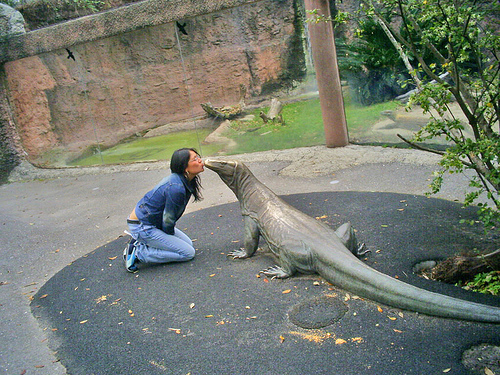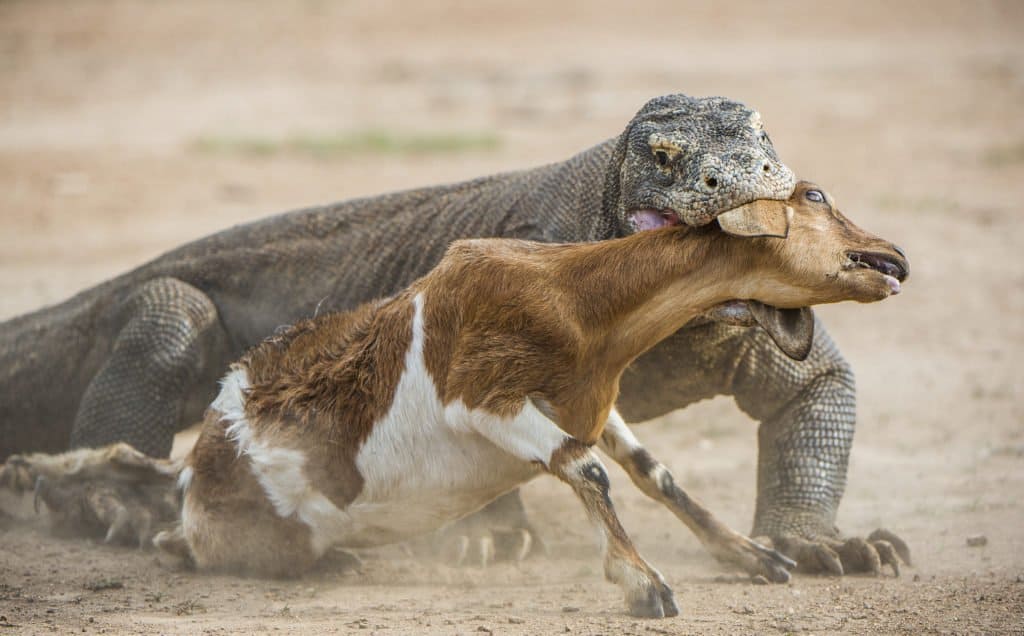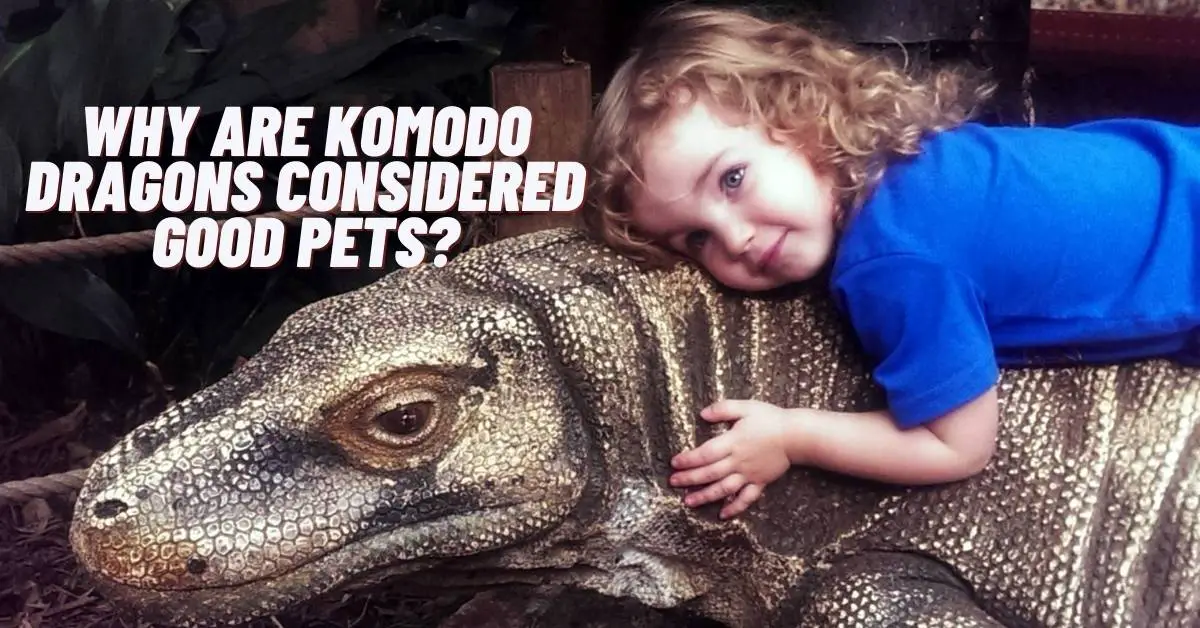Komodo dragons are unique lizards that weigh up to 300 pounds and are found across Indonesia and in a few Zoos in the US. Their size and appearance make them look a lot like dragons or dinosaurs. Komodo dragons are a type of monitor lizard (known as the Komodo monitor) that grow to lengths of 10 feet. These lizards are popular due to their large size, which is why they became an ecotourist attraction. It’s not uncommon for people to get so attracted by these unique lizards to the extent that they’ll want one for themselves.
But then, what are the chances of owning one? And do Komodo dragons really make good pets?
Why Are Komodo Dragons Considered Good Pets?
Komodo dragons are considered good pets by some people due to their seemingly docile nature, their large size, and the fact that they look like cool mini-dinosaurs. However, this notion is wrong. A Komodo dragon can never make a good pet, and there are many reasons for this.

Komodo dragons are big, wild lizards with the same weight as a small hippo. However, unlike a hippo, Komodo dragons are carnivores. This means that by keeping one in your home, you’re endangering everyone around you. Their wild nature makes them very unpredictable; plus, there’s been no record of anyone who domesticated them completely, as you find with domesticated tigers and lions.
Is it legal to have a Komodo dragon as a pet
No, it isn’t. Komodo dragons are not legal to own in any country, even in Indonesia. At the very most, you may find this animal in zoo captivity, but other than that, there’s just no way they can be in individual captivity (unless, of course, you’re a poacher and willing to face the full wrath of the law).
What is it like owning a pet Komodo dragon
Komodo dragons seem to be quite docile, friendly, and smart when viewed in zoos, and this may make some people believe they’ll make good pets. However, the reality of owning one is a whole different story:
Is it safe?
No, it isn’t. Having a Komodo dragon at home is like having an unpredictable dragon that can kill you before you know it. Like snake-owners are at risk of getting killed by their snakes, having a Komodo is about the same but on a much larger scale and risk level. A Komodo can poison you with its venom and watch you die, chop off your fingers/limbs with its powerful jaws, or devour any smaller animals and babies in the vicinity when it’s on a rampage.
Feeding
Komodo dragons are meat-eaters, meaning they’ll devour a lot of meat. This animal must eat up to 80% of its body weight each day (remember, they can weigh up to 300 pounds): so that means you’ll be budgeting a huge part of your salary to feed your lizard-dragon.

Another danger here is that Komodos are natural hunters, so any/every pet in your home or around your home is in danger. Komodo dragons are apex predators, from Cows to deer, dogs, snakes, and birds; they eat almost anything. Even little children and toddlers can become prey for a Komodo when it reaches a significant size.
Physical Care Health Care
There are no tutorials online or offline, no YouTube videos or any of the sorts that tell you how to groom Komodos: This is because, unlike your dogs and cats, Komodos aren’t made to be petted. So if you own one, keeping and maintaining good hygiene for your Komodo will be very tasking. Plus, you’ll be putting yourself at risk of getting bitten every time you try to say, brush its teeth or trim its nails.
Also, unless you have a friend at a zoo that keeps Komodos, who knows how to keep them healthy, you’ll likely be at a loss on keeping your Komodo healthy. Regular Vets won’t be able to treat these monster lizards.
Training

With no experience, you’re at a loss with how to train a Komodo. The only way out is to seek out a zoo that features Komodos and ask the zoo attendant questions about how they manage/train their Komodos. However, even if you get the tricks or training manual for a Komodo, having adequate space and habitat (trees, grasses, etc.) to train them can be a major challenge. Komodo dragons take up a lot of space for caging, and they’ll even need more space for training.
5 Reasons why you shouldn’t keep a Komodo
They eat a lot of meat
Komodos have a nasty appetite. They are voracious eaters with powerful jaws that munch on virtually anything they can lay their hands on. They scavenge on corpses (even human corpses) and can also turn cannibals in some cases.
They’re Venomous
Komodo dragons are highly venomous, and it’s not just because of the numerous bacteria they have in their saliva; Komodos have venom glands, just like snakes. When hunting, a Komodo simply bites its prey and waits patiently for the venom to kill it before feasting on it.
:max_bytes(150000):strip_icc()/4-657592e5ef0c4eef932b0ea88f6e0840.jpg)
They can attack swiftly
Komodo dragons can be surprisingly very fast, especially when hunting and feeding. They always go into a frenzy when they smell or see blood (this is why women on their periods are not permitted to see them in the wild). Also, Komodo dragons have attacked humans on several occasions.
They’re endangered
Komodo dragons are a protected species. Due to conditions like poaching and loss of habitat, they’re almost extinct. So asides from the fact that no national laws permit ownership of these animals, these animals are also protected internationally. You’ll spend a lot of jail time if you’re caught keeping one in your backyard.
They smell
Komodos have really bad hygiene, especially when it comes to dental hygiene. Their saliva contains over 50 different kinds of bacteria, and it’s also highly toxic. As if that weren’t enough, Komodos secrete this saliva in a disgusting drool, especially when feeding.
The smell from these lizards (especially their mouth) is second to none, and will definitely keep you away from petting or even playing with them.
What similar animal can I keep as a pet instead of a Komodo dragon?
In case you have a thing for monstrous or large lizards, here are some pets you can keep instead of a Komodo. These lizards are by no means domestic, but they’re non-venomous, and you’ll be safer and more comfortable with them than with a Komodo dragon.
| LIZARD | SIZE | NATURE/BEHAVIOUR | LIFE SPAN |
| IGUANA | Large (up to 5 feet) | Intelligent, Very docile (sleeps a lot) | 20 years |
| Nile Monitor | LARGE (up to 6 feet) | Mostly aggressive | 20 years |
| Asian Water Monitor | LARGE (up to 6 feet) | Cool and mostly docile | 25 years |
| Bearded Dragon | Medium (up to 2 feet) | Extremely docile, great pets for kids | 15 years |

I’m Christopher Benjamin, a dedicated Animal Nutritionist at Ethos Veterinary Health with a Bachelor of Science in Animal Science from Michigan State University. My lifelong passion for animals led me to establish AnimalsData.Com. Here, I share expert advice, educational resources, and inspiring stories to empower fellow pet lovers worldwide. Join our community as we celebrate the beauty and diversity of our beloved animal companions!

